 |
|
Arborists & Tree Loppers often find termite infested trees and may need to give general advice on termites and termite control options for home owners in the Baulkham Hills Council Region.
Glenn DuBois of FUMAPEST Termite & Pest Control Baulkham Hills • provides expert advice on professional Termite Control options • AS.3660 Termite Inspection Reports • AS.3660 Termite Barriers • Soil Treatment Termiticides • Pesticde Safety • Termite Baiting • Follow-up AS.3660 Termite Inspections.
Glenn DuBois is Technical Director at FUMAPEST • Secretary of Australian Pest Control Association • Bachelor of Arts (Macq) • Master of Commerce (UNSW) • TAFE Urban Pest Control Certificate • served on NSW Govt Pest Licensing Board & Standards Australia Termite Control Committees. |
|
Destructive Termite Species in Baulkham Hills Council Region |
|
Summary of Termite Control options • updated January 2022
|
HOME-OWNERS in the Baulkham Hills Council region who find signs of termite activity inside their home have several options for professional protection from continued termite infestation and timber damage in the building.
Termite Inspection & Report to AS.3660 • firstly, a thorough inspection of all buildings and surrounds • with a written report to AS 3660 • covers areas inspected • evidence found of termite activity • high risk termite entry areas inaccessible to inspection • and termite control options and limitations.
|
AS 3660 Termite Barrier • Chemical Soil Treatment around the perimeter and sub-floor of a building • to eradicate termites attempting to gain entry into the building • a complete continuous barrier not always practicable • however this is best long term protection option available in most situations • the use of Termidor or Premise termiticide is highly recommended.
|
Termite Baiting • involves the installation and monitoring of termite bait stations containing Nemesis • Exterra • or Sentricon Termite Bait • this method relies heavily on the subterranean termites "finding" and consuming sufficient termite bait • highly recommended in limited circumstances • where live termites are found and the ternite bait can be directly attached thereon.
|
Building Modification & Maintenance • termite risk reduction measures that can be carried out by the property owner • this may include • improving subfloor ventilation • removal of timber in contact with the soil • improving inspection access areas.
|
| Subsequent Inspection & Report to AS.3660 • Essential • at least at every 3 to 6 months intervals in high risk situations • such as, where signs of termite activity have previously been located closeby susceptible buildings or timber structures. |
|
Termite Inspection & Report • Australian Standard 3660
|
A Termite Inspection & Report involves a thorough inspection of the buildings and surrounds • a written inspection report on evidence found of termites and termite activity • details of any high risk termite entry points that are inacccessible to inspection • and specifications to AS.3660 for an integrated termite control program • the inspection and report should be received and considered in detail before any protective measures are commenced.
The cost of a Termite Inspection Report to AS.3660 is approx $300 for an average size residential building • depending upon size and style of construction • ease of inspection access • and the time involved in conducting a proper inspection.
|
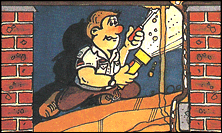 |
Specific areas inspected include all accessible timbers within the crawl space in the sub-floor • roof void area • interior • exterior • garden landscaping • fences • and where practicable any other timber structures and trees within a 50 metre radius of the buiklding.
Termatrac termite detection equipment is used where we know or suspect that a termite sub-nest is present inside the wall cavities of the building. |
|
AS.3660 Termite Preventive Barriers • Chemical Soil Treatments
|
Home Insurance does NOT covertermite damage to structural or other timbers inside a residential or commercial property, which could be severe • the replacement cost of termite infested structural timbers in the roof and wall may exceed $50,000.
FUMAPEST has Professional indemnity insurance to cover future termite damage to structural and decorative timbers in a building after we have carried out a complete Termidor soil treatment service to AS 3660 • FUMAPEST highly recommends the use of Termidor Soil Treatrment Termiticide as the most effective termite protection product commercially available in Australia.
Termites in the Building at the time of AS 3660 Soil Treatrment • cannot safely return to their central colony nest through the chemically treated soil • termites usually need to return every few days to their central underground nest to obtain moisture essential for their survival and to feed and groom other termites • the king • queen • reproductives • soldiers • young nymphs.
Expert Knowledge and specialised equipment is required to form a complete and continuous barrier arund the building in order to to protect the building from a termite entry and infestation • as illustrated below: |
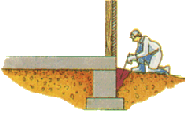
|

|
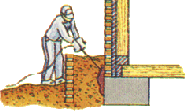
|
Trench and treat soil with Termidor around
external concrete slab edge
A COMMON TERMITE ENTRY POINT
|
Trench and treat soil around walls
and piers in the sub-floor area
with Termidor Termiticide
|
Use rod injection to treat soil
along and around the external
perimeter areas of the building
|
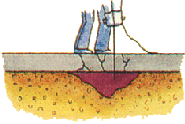
|
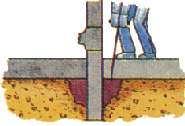
|
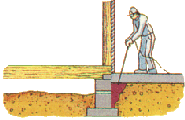
|
Drill concrete floor along all
expansion joints and cracks
and treat soil thereunder
|
Drill concrete floor around pipes
and treat soil thereunder with
Termidor Termiticide
|
Drill concrete patio areas and treat
soil area therein - a HIGH RISK
Termite nest location
|
|
| |
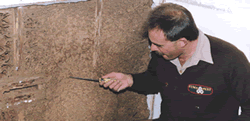 |
Termites sometimes nest inside a building • in a roof or wall cavity where moisture is regularly supplied eg from faulty plumbing • leaking shower recess • broken roof tiles • or faulty guttering, allowing water into wall cavity.
Termatrac termite detection equipment is used by FUMAPEST where we suspect a termite sub-nest is present inside a wall cavity in the building.
Micro-wave technology embodied in the Termatrac equipment enables accurate detection of termite movement and activity inside a wall cavity. |
|
|
Pesticide Safety Issues • Soil Treatment Termiticides
|
|
Termite Control Chemicals are required to be assessed and approved by Federal Govt APVMA • for example • approved termiticides include • Termidor • Premise • Biflex • Dursban. Some approved termiticides include an organo-phosphate pesticide emulsified with xylene a solvent based chemical.
Modern Technologies • Termidor and Premise are NOT in the organo-chlorine or organo-phosphate pesticide group. Both Termidor and Premise are highly effective at termite colony elimination.
Solvent based termiticides are NOT used by FUMAPEST even though they are much cheaper. Solvent based termiticides are known in certain circumstances to cause health problems for people with asthmatic or bronchial ailments. We recommend Termidor for safety and long term effectiveness.
Water based • Termidor and Premise are water based • with virtually no smell and of ultra-low hazard to humans, dogs, cats and other mammals.
No fumes whatsoever • Termidor and Premise do NOT have an obnoxious odour or emit airborne residues or fumes. Both are registered by Federal Govt AVPMA as a low hazard insecticide with a CAUTION notation on the registered label. Termidor is manufactured by BASF and Premise by Bayer.
Fipronil the active ingredient in Termidor is also used in Frontline the flea and tick control product used on millions of cats and dogs in Australia and the USA, without any health issues arising.
Dursban & Biflex have a strong repellency action • the termites can detect the chemical and so avoid it • they can easily move along the perimeter of the treated soil areas, actively seeking a gap to gain entry into the building • In cases where it is virtually certain of installing a completely uniform and continuous barrier, the use of either Dursban or Biflex termiticide may be sufficient.
Non-repellant Termiticides • Termidor and Premise are much more certain and effective, in that the termites cannot avoid what they cannot detect • the chemical adheres to the skin of the worker termites or they ingest it when tunneling through treated soil areas.
Termidor & Premise • exhibit a delayed lethal effect on affected termites of several days • enough time for the fipronil chemical to be spread around the colony nest by the termites mutual feeding and grooming habit • with sufficient consumption of the chemical, the entire colony is eliminated.
Scientifically Proven • Termidor and Premise are scientifically proven as being readily transferred from one affected termite to another • the technology is aimed at eradicating the entire colony • the mode of action is illustrated below.
FUMAPEST provide a 6 YEAR WARRANTY for a complete Termidor Soil Treatment to AS.3660 • subject to annual inspection regime • Termidor Treatment Cost is usually between $2,000 to $4,000.
|
|
|
Termite Baits • Termite Baiting Systems • Advantages & Limitations
|
Termite Baits registered in Australia by Federal Govt APVMA are Nemesis - Exterra - Sentricon & Termitrix Termite Baits.
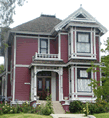 |
FUMAPEST uses Nemesis & Termitrix Termite Baiting Systems • the Australian owned and developed products • both Exterra and Sentricon are USA owned termite bait products.
Termite Baiting Systems consist of a number of plastic bait stations for in-ground and above-ground installation where active termites have been located, together with termite bait chemical.
Nemesis & Termitrix Termite Bait contain the chemical chlorfluazuron • an IGR insect growth regulator. |
 |
How the NEMESIS Termite Bait works: once they find the bait the worker termites readily eat it • they reguritate the termite bait to feed other termites in the central colony nest • termites must regularly shed and regrow their outer-skeleton • the IGR stops this regrowth and they die shortly thereafter • the worker termites cannibalise other dead termites further spreading its lethal effect throughout the termite colony • with sufficient termite bait consumption the entire termite colony is eradicated. |
Regular monitoring is required • the use of Termite Baits must be subject to regular inspection and monitoring by the termite controller • the more termite bait consumed, the quicker and more certain is the termite colony elimination process.
FUMAPEST Policy is to attach the termite bait directly over known live termite activity areas • the rate and amount of consumption is monitored for several weeks • and if practicable thereafter, a complete chemical soil barrier treatment using Termidor Termiticide be applied around the perimeter of the building and other high risk entry points.
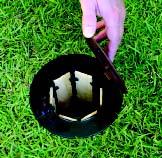 |
LIMITATIONS of Termite Baiting • Be Careful • many pest control companies sell a termite "monitoring" system of plastic boxes (timber inside) inserted in the soil around the external perimeter of a building • to be effective this assumes the termites will "find" the stations, infest the timber therein and then termite bait added • termites are blind • travel in underground tunnels • are more likely to enter your home - a far bigger food source to find than little plastic boxes in the ground.
Termites have acute survival instincts • too much disturbance of the foraging termites (workers and soldiers) in a particular location, this may well alert the termite colony to abandon the immediate area • they appear to be gone, but may be entering the building in other areas inaccessible to inspection. It is often difficult to be confident the termite colony has in fact been eradicated. |
Termite Baiting is sometimes unreliable • Termite colony elimination in favourable circumstances may take several weeks to a few months • in some cases, termite colony elimination is unsuccessful or may take years.
It depends if sufficient termite bait is consumed by a large number of termites • then colony elimination is virtually assured within a few months • the experience and skill of the pest controller is paramount, in order to properly decide if and where a baiting program is to be implemented and properly monitored.
Proper Termite Baiting can be Expensive as it is usual to reinspect the bait stations, the building and surrounds every month to reposition, reapply or replenish the termite bait • this process is labour intensive so that the long term cost of the monitoring and baiting system may accumulate out of hand before the chance of success or otherwise, is realised.
Consumer note • some pest controllers offer termite baiting at ridiculously low prices that does not cover direct materials and labour • they collect all the money upfront for future inspections • and dissappear • or they fail to advise that a Termite Preventive Barrier to AS.3660 is the best long term option • BEWARE the NSW Govt WorkCover Pest Control Licensing system in NSW is inadequate. Some individuals have a NSW Pest Control Licence with little training or experience ... more details below.
|
 |
Ring the Experts: Dont bet your house on a DIY Termite Control Solution • successful termite protection of a building using a baiting program often requires expert skill and judgment, based upon years of field-work experience in termite control in a wide variety of circumstances.
Live termites found? • Remember • one critical aspect is that the bait stations only be to installed in areas where live activity is found • otherwise the termites must blindly "find" the stations to have any chance of widespread termite bait consumption and successful termite colony elimination. |
No absolute guarantee: With a termite baiting program, there can be no absolute guarantee of long-term protection of nearby buildings • there may be other termite nests nearby the building that do not find the bait stations.
Your home is a much bigger target • other termite nests may exist in trees, under concrete on-ground flooring and in-fill patios of neighboring properties • and be unaffected by the baiting program • even if termites happen to find the "in-ground monitoring" stations and when bait is added this may disturb the termites so they avoid the in-ground bait station, entirely. |
FUMAPEST Policy is to apply the termite bait directly onto known live termite activity areas • the rate and amount of consumption is monitored for several weeks • and if practicable thereafter, a complete chemical soil barrier treatment using Termidor Termiticide be applied around the perimeter of the building and other high risk entry points.
An Integrated Approach: A termite baiting program should be part of range of options including • drilling susceptible trees and eradication of any termite nest located therein, and • follow up chemical soil treatment using Termidor or Premise.
FUMAPEST provides a 6 year warranty for a complete Termite Preventive Barrier Soil Treatment to AS.3660 using Termidor Termiticide • subject to an annual inspection regime • such a Termidor Treatment Cost is usually between $2,000 to $4,000. |
|
Home Owner recommendations • Building Modifications & Maintenance
|
Listed below are some useful recommendations for the home-owner to carry out in order to help reduce the risk of undetected termite activity inside a building.
Rapid termite colony development and building infestation is usually associated with a readily available timber food and moisture source nearby the central nest. Buildings are often constructed in a way that allow termites to gain undetectable entry from the soil to the structural timbers of the building.
(1) Moisture exclusion from inside the wall cavities, around the base of the building and sub-floor area. Exclude excessive water run-off from a sub-floor area by the installation of ag-drains. Ensure adequate cross flow ventilation in the sub-floor area.
A qualified plumber should ensure there is no water leakage from plumbing pipes in bathroom, shower recess, kitchen, down pipes, guttering and air conditioning overflow. Look for dampness in wall cavities, broken roof tiles, faulty guttering and the like. Hiigh humidity, dampness or moisture accumulating in a wall cavity encourages large scale termite activity inside the building.
(2) Removal of any timber in contact with the soil. Timbers should be stored above ground level to allow full inspection for termite activity. Any landscaping using timber chip mulch and railway sleepers should be removed, as they provide ready food source to assist in rapid termite colony development.
(3) Ensure inspection access is unimpeded, particularly in sub-floor areas of suspended floors, in order to look for evidence of termite activity. If your home is on concrete slab on-ground flooring, make sure you can inspect the entire external slab edge for evidence of termite mud-shelter tubes. Do NOT allow this area to be covered by pavers, landscaping, planter pots, etc, as termites often gain entry into the wall cavity through external weep holes and gaps in the mortar of brick-work.
If you find live termites DO NOT disturb the area. DO NOT use spray insecticides on the termites. If sufficiently disturbed, the termites may move elsewhere and not be rediscovered until severe damage has been done. The termite controller can install a termite bait on the termite activity area to maximise bait consumption by the termites and elimination of the entire colony. |
|
Regular follow-up • Termite Inspections & Monitoring
|
 |
AS.3660 Requires Follow-up Inspections after the installation of a chemical soil barrier to AS.3660 be carried out at least 3 to 6 monthly intervals where the termite risk is high.
FUMAPEST Policy is usually to recommend 3 or 6 monthly inspections be carried for the first 24 months following a chemical soil treatment. If all seems OK then annually thereafter.
FUMAPEST Professional Indemnity Insurance covers subsequent termite damage provided a complete soil treatment and follow-up inspections are carried out to AS.3660.
|
Don't Risk - DIY Termite Control • this is a job for the professionals • the correct identification of a destructive termite species • inspection of a building for tell-tale signs • analysis of your circumstances and the design and implementation of an effective program for the protection of a building from termite infestations • requires expert skill and judgment based upon professional training and extensive field-work experience in termite control in a wide variety of circumstances. |
| Termites and Termite Control PDFs |
|
WARNING: The NSW WorkCover Pest Control Licensing is INADEQUATE
|
|
Be Careful in selecting a Pest Controller • Unfortunately • it is far too easy to get a NSW Government WorkCover issued pest control licence and start up a Pest Control business in NSW with little knowledge or experience in providing safe and effective pest control services • click here for more details.
The NSW Pest Control Licensing system is subject to National Competency Assessment guidelines. Mediocre testing can be carried by Private Workplace Assessors (not part of TAFE system). The so called competency assessment can be a combination of oral, written and visual tests ie maybe 1% in writing.
Private Workplace Assessors are given general guidelines in the National Competency Standards but there is no set standard test or specific knowledge requirements. Once privately assessed as "competent" then the NSW WorkCover Pest Control Licensing will issue a pest control licence to the individual. There is no published list of Private Workplace Assessors so it is difficult to gauge the extent of the problem.
The System is Inadequate: Some Private Assessors offer a one week course. A person so issued with a pest control licence can set up a Pest Control business (not required to register with WorkCover) and employ an unlimited number of trainees, using pesticides in people's homes without direct personal supervision.
FUMAPEST Setting the Standard in an industry plagued by fly-by-night operators, FUMAPEST Termite & Pest Control stands out as a reputable pest control business with excellent reputation in the market-place.
Same Family Business • Since 1964 • Termite & Pest Control Specialists |
|
|
|
FUMAPEST Termite & Pest Control services the Baulkham Hills Council Region
|
|
